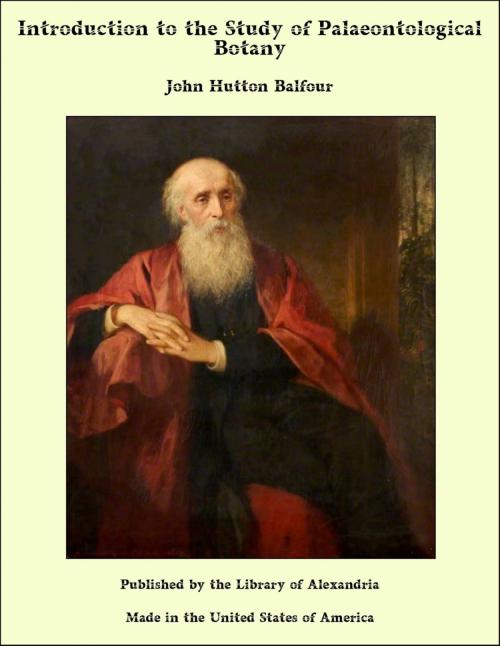Introduction to the Study of Palaeontological Botany
Nonfiction, Religion & Spirituality, New Age, History, Fiction & Literature| Author: | John Hutton Balfour | ISBN: | 9781465619273 |
| Publisher: | Library of Alexandria | Publication: | March 8, 2015 |
| Imprint: | Language: | English |
| Author: | John Hutton Balfour |
| ISBN: | 9781465619273 |
| Publisher: | Library of Alexandria |
| Publication: | March 8, 2015 |
| Imprint: | |
| Language: | English |
The subject of Fossil Botany or Palæophytology has formed a part of the Course of Botany in the University of Edinburgh for the last twenty-five years, and the amount of time devoted to the exposition of it has increased. The recent foundation of a Chair of Geology and of a Falconer Palæontological Fellowship in the University seems to require from the Professors of Zoology and Botany special attention to the bearings of their departments of science on the structure of the animals and plants of former epochs of the Earth's history. No one can be competent to give a correct decision in regard to Fossils, unless he has studied thoroughly the present Fauna and Flora of the globe. To give a well-founded opinion in regard to extinct beings, it is essential that the observer should be conversant with the conformation and development of the living ones now on the earth; with their habits, modes of existence and reproduction, the microscopic structure of their tissues, their distribution, and their relation to soil, the atmosphere, temperature, and climate. There can be no doubt that to become a good Fossil Geologist a student must begin with living animals and plants. The study of Geology must be shared by the Petralogist, who looks at the condition of the rocks of the globe, the minerals forming them, and their mode of formation; the Chemist, who determines the materials which enter into the composition of minerals and rocks; the Naturalist, who examines the plants and animals found in the various strata; and perhaps also the Natural Philosopher, who calculates from independent sources the phases of the Earth's history. It may be said thus to combine all these students of Science in one brotherhood. Much has been done by the efforts of such men as Hutton and Werner, who were engaged chiefly in considering the mineral department of Geology; but it is clear that the Science could not have attained its present position without the continued labours of those who have been examining fossils in their relations to time and space. Had it not been for the researches of Palæontologists, Geology could not have made its present advance. In my Class Book of Botany I have given an introduction to Palæophytology, and it occurred to me that it might be useful to students to publish this in a separate form, with additions in both the letterpress and the illustrations. The institution of the Palæontological Fellowship, in memory of my former friend Dr. Falconer, has brought the subject specially under my notice. The Fellowship has been promoted chiefly by my friend and former pupil Dr. Charles Murchison, a gentleman fond of science and of his Alma Mater, the University of Edinburgh, where he and Falconer studied and took their degrees.
The subject of Fossil Botany or Palæophytology has formed a part of the Course of Botany in the University of Edinburgh for the last twenty-five years, and the amount of time devoted to the exposition of it has increased. The recent foundation of a Chair of Geology and of a Falconer Palæontological Fellowship in the University seems to require from the Professors of Zoology and Botany special attention to the bearings of their departments of science on the structure of the animals and plants of former epochs of the Earth's history. No one can be competent to give a correct decision in regard to Fossils, unless he has studied thoroughly the present Fauna and Flora of the globe. To give a well-founded opinion in regard to extinct beings, it is essential that the observer should be conversant with the conformation and development of the living ones now on the earth; with their habits, modes of existence and reproduction, the microscopic structure of their tissues, their distribution, and their relation to soil, the atmosphere, temperature, and climate. There can be no doubt that to become a good Fossil Geologist a student must begin with living animals and plants. The study of Geology must be shared by the Petralogist, who looks at the condition of the rocks of the globe, the minerals forming them, and their mode of formation; the Chemist, who determines the materials which enter into the composition of minerals and rocks; the Naturalist, who examines the plants and animals found in the various strata; and perhaps also the Natural Philosopher, who calculates from independent sources the phases of the Earth's history. It may be said thus to combine all these students of Science in one brotherhood. Much has been done by the efforts of such men as Hutton and Werner, who were engaged chiefly in considering the mineral department of Geology; but it is clear that the Science could not have attained its present position without the continued labours of those who have been examining fossils in their relations to time and space. Had it not been for the researches of Palæontologists, Geology could not have made its present advance. In my Class Book of Botany I have given an introduction to Palæophytology, and it occurred to me that it might be useful to students to publish this in a separate form, with additions in both the letterpress and the illustrations. The institution of the Palæontological Fellowship, in memory of my former friend Dr. Falconer, has brought the subject specially under my notice. The Fellowship has been promoted chiefly by my friend and former pupil Dr. Charles Murchison, a gentleman fond of science and of his Alma Mater, the University of Edinburgh, where he and Falconer studied and took their degrees.















